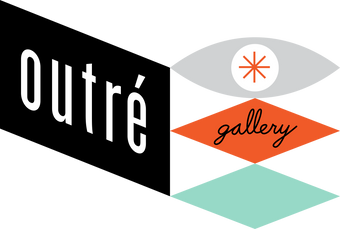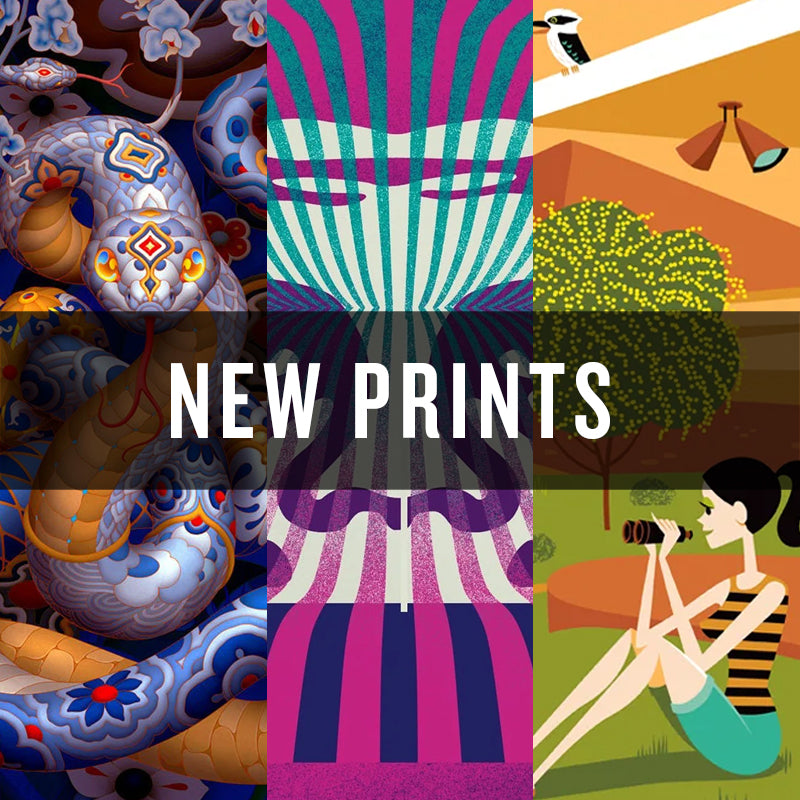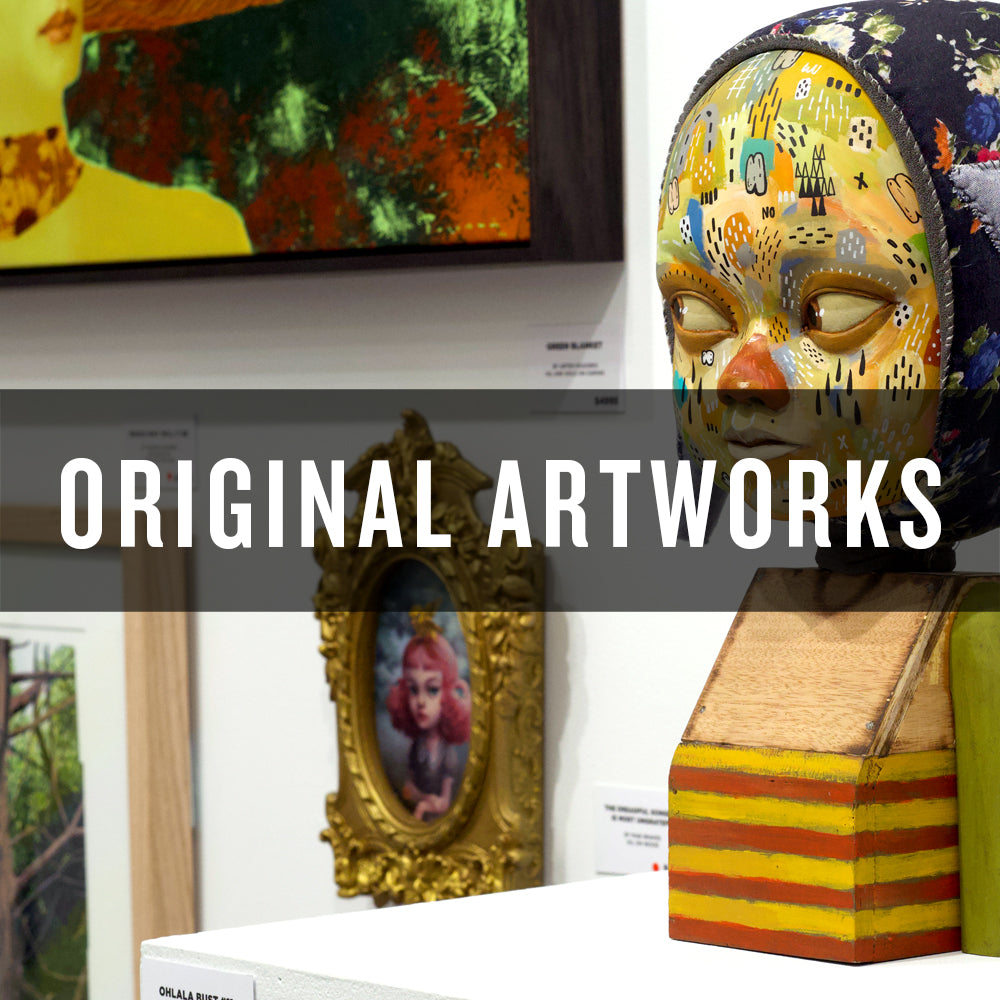
Kozy Kitchens is a visual artist from Japan, living in Los Angeles over half her life now. Making with clay is a purely joyful experience for her. Her hand built ceramic sculptures and functional objects are playful, often humorous, and influenced by a deep appreciation of animals and the natural world. She also creates drawings, paintings, murals, and other projects under the moniker kozyndan (often along with her husband, Dan).
Kozy's show Kintsugi Kozy opens June 30.
Interview by Mel Parker. Images supplied by Kozy Kitchens.
Welcome back! We’ve hosted you a few times now at Outré, which is always a pleasure. Tell us about this show - what can we expect from you this time around?
Thank you so much for showing my work. I have been making these 'Bunny Primitive' sculptures for almost 10 years. They are a way to express the intuitive childish part of me.
The aesthetic wabi sabi is sometimes described as one of appreciating beauty that is "imperfect, impermanent, and incomplete" in nature. It is prevalent in many forms of Japanese art. One of the many reasons that I decided to move back to Japan from the US was to study and practice Eastern philosophy. A lot of Japanese beliefs are based in Buddhist philosophy. Ceramics have so much history in the tea ceremony here and are related to Zen philosophy, so by practicing ceramics I get to feel the idea of Zen (which I still really don’t understand). I think it was harder to feel it when I was living in the US.
In Japanese “to give up” is akirameru but it originated from akiraka ni miru which means “to see more clearly” – the word comes from a Buddhist idea. It’s different from the English meaning of “to give up.” It means more like “to find what is more important and prioritize it.” I feel like sometimes I am failing at my art career - I gave up on living in the US - but when I think of akirameru in Japanese, it reminds me that I had so many good intentions in moving to Japan, and it was very important for me to reconnect to Japanese culture.
Practicing kintsugi and using locally made washi paper for kozyndan’s limited edition prints is also the way to continue traditional Japanese crafts and introduce them to non-Japanese viewers.
Since Dan and I moved to Japan from Los Angeles, I have been firing my sculptures in the traditional wood firing kilns in the Japanese countryside. I am always surprised by the unexpected looks of my sculptures from wood firing kilns. Each wood fired ceramic piece is unique because we don’t have perfect control over how the fire acts or how air flows in the kilns. The clay and glaze react very differently in wood fired kilns. The ash from the firewood falls on the pieces, melts around 1250ºC, and becomes a natural glaze. Wood firing ceramics forces you to practice non-attachment. If you have clear visions of what your ceramics should look like, wood firing is almost always disappointing. But if you can accept any unexpected outcome, it becomes very magical. The process is a collaboration with earth, water, air, and fire!
The show is a small collection of these wood fired ceramics. In addition, I had a quite few glazes that I tested in wood firing kilns and they just didn’t work out at all, and I needed more controlled airflow (oxidation), so I fired some of them in the kerosene kilns. Letting go is a continuous and conscious practice.

The title of your upcoming show is ‘Kintsugi Kozy’ – can you describe the meaning behind this title?
Kintsugi is the Japanese art of repairing broken pottery by mending the broken areas with lacquer called ureshi – it’s like poison oak and makes your skin irritated, it’s the oldest natural superglue – dusted or mixed with powdered gold or silver.
Some glazes run and get stuck in the kiln shelves, and when I try to get the pieces out the legs of the sculpture often snap off. It was a very common occurrence even when I was firing in the gas kilns in LA. I usually didn’t save broken sculptures, I used to put them in our patio by our cacti. Pieces break off or crack more often in wood firing kilns. I started to take kintsugi class since kintsugi classes are more widely available in Japan.
We have this expression mottainai in Japanese; it is most commonly used to express a feeling of regret when something is put to waste without deriving its value. Japanese people fix ceramic pieces with kintsugi, often functional items like cups and plates because they feel mottainai – these ceramics pieces hold good memories or sentimental value, like it used to be your mom’s favourite tea cup, etc.
My kintsugi sculptures almost always have stories about overcoming trauma, injuries, and difficulties. I used to get so disappointed when my sculptures broke in the firing process, but now it’s very exciting when they break because I get to do kintsugi surgery on them now. I gladly accept imperfections now. And I try to incorporate the concept of accepting imperfection in other situations.
Imperfection makes things more unique and interesting. I try not to get stressed over things that I can’t control, but I have control on my emotions and thoughts. And practicing this concept makes me more stably content.

You are clearly adept at many mediums, from painting to murals to your clay pieces. When did you first fall in love with ceramics in particular?
I started playing with ceramics as a hobby in 2012 because I was getting burned out from painting and drawing. The kozyndan style is pretty controlled and highly detailed; our panoramic style requires a lot of composition and character design planning.
Playing with clay expresses a more childish and illogical side of my creativity. I work more intuitively with clay and glazes; I feel like I use the left side of brain while I work on kozyndan art, and I use the right side of my brain while I work on my ceramics. I came to Japan and discovered the joy of wood firing ceramics during ceramics residencies at Shigaraki and Shirooni in 2018. I found the house we are living in in the summer of 2018, and also a few wood firing kiln ceramics studios here in Yamanashi.
The wood firing ceramics kilns near where we live were built by three guys in the forest about 30-40 years ago - they are in their mid 70s now, so they are thinking of retiring soon. They were talking to me about demolishing everything they built. I really wanted to save the place because it’s so magical! (And so mottainai!)
Coincidentally, the art book publishing company, Gas Book, moved into the old Velbon tripod factory near us. They opened their space as an art gallery and artist residency, calling massive art complex ‘Gasbon’. The wood firing kiln owners knew an old ceramicist lady who wanted to get rid of her kerosene kiln and glazes […] I adopted her kiln and moved it to the art complex to build a ceramic studio with Gasbon. I found another gas kiln and old dried up clay at another retired ceramicist’s studio, and Gasbon adopted it. The ceramic artist who is currently staying at the residency fixed these kilns and found an electric kiln. The wood firing kilns are going to be passed down to the artists at Gasbon.
The owners of the wood firing kilns have started to teach us how to make firewood. They go to the mountain to chop red pine with chainsaws, transport the logs to the kilns in their trucks, [then] they use their firewood making machines and an axe to make firewood. They stack the firewood to cure for up to one year. Dan and I, and artists from Gasbon, go there every Tuesday from 9am-5pm. We probably have to go 5-6 more weeks to finish making firewood from all the logs they prepared for this fall and next spring’s firings. It’s a lot of physical labour! They will teach us how to fire and fix wood firing kilns this fall. The wood firing kilns are so labour and time intensive; it’s so different from an electric kiln which you can fire ceramics with the push of a few buttons. We hope to have working kerosene, gas, and electric kilns as well as traditional wood firing kilns for artists who want to explore different options. We also hope to pass down the tradition of wood firing ceramics kiln techniques to future generations of ceramicists. I hope to open our renovated 130-year-old farmhouse for artists (especially Asian immigrants in Western countries) who want to connect to Japanese traditional craft.

Were you always creative? What are some of your earliest inspirations or memories of creativity?
I think so. Both of my parents are creative, especially my father. He went to school for fashion, but he had to take over my grandfather’s family business. They make Buddhist and Shinto products for temples and shrines. My family were paper makers for over 200 years. I had to help them a little when I was growing up, so I feel like I learned about crafting, packaging, and even shipping from my family business.
Both of my parents play music, mostly Peruvian and Bolivian music. They are good at cooking, my dad used to make clothes, and my mom used to knit a lot. They were so creative (I think older generations were much more creative and it was more normal?). They were my initial inspirations. I got into different sorts of manga when I was growing up and always loved drawing. I was around a lot of washi paper because of my family. It felt like I had infinite resources for doodling and paper crafting as child.

Animals feature prominently in your work, especially bunnies - what attracts you to rabbits (and the natural world as a whole) as a subject?
We had pet bunnies when we were starting as young artists. Bunnies were good models, so we drew them a lot. No hidden messages or anything. We are more cat people. Haha.
You often work collaboratively with your husband Dan - how does your approach differ when making a solo collection of work compared to a collaborative effort? Are there pros and cons to each?
I have more creative freedom when I am working on my ceramics. I am a very stubborn person. I usually have very clear idea of making kozyndan painting my way, and sometimes Dan disagrees, so Dan and I used to have some arguments about how we should make our artwork. But nowadays we know our creative strengths or weaknesses, so we try to let go of our egos. We have been working together for so long, so the art making process is easier. If we are working on a project which is suitable for his personality or style, I let him have more creative control and I play more of a supportive role, and vice versa.

Speaking of Dan, I read that he gives a name and a story to each of your ‘Bunny Primitive’ works! Are there any particular favourites that have stuck with you, or any that you relate to more than others?
Yes, he did name and give a story to a majority of them, but also some stories were written by me, and our friends, and my family. Some were contributed by kozyndan fans on my Instagram. Some of my favourite stories were written when we wrote them with our friend Katie because she came up with super ridiculous ideas. We had story writing dinner parties with our friends, Raina and Ganda, and they came up with great ones. Some are named after our actual friends.
There are about 600 of them now. I like stories with dark humour or characters with flaws. I read back most of stories now, and some of them are so dark and fucked up! Dan named and wrote stories for almost all sculptures for this year's show! Dan’s stories for Outré show are less sarcastic and more wholesome, I thought. He did an incredible job photographing them too!

What can we expect from you in the future? Any sneak peeks of cool projects on the horizon?
My intention of moving back to Japan was to build a homestead farm/artists’ retreat. We moved here right when the pandemic got serious in March of 2020. The Japanese government closed off the borders and tourists couldn’t come visit for 30 months or something! We moved to Japan so our friends can come stay at our house and experience Japanese culture, etc. Japan was not a bad place to be stuck alone during the pandemic, but we were lonely.
We worked on our kominka (old house), organized our overgrown bamboo grove, and learned how to grow food during the pandemic. We planted mushroom spores in logs, so we get shiitake mushrooms in our garden. We learned how to grow organic rice from our friends’ dad. We grew 15 (maybe more?) varieties of tomatoes, we made dried tomatoes in olive oil. My sister’s family love it and my sister asks for it every summer. We grew habanero peppers to make hot sauce. At the moment it’s bamboo shoot and raspberry season in our back yard. So I am cooking a lot of bamboo shoot dishes, and I made raspberry jam this week (because my mom has been making jam this year a lot, so I wanted to give it to her in return) Also it’s firefly season here now, so after dinner we go watch fireflies by the creek in our backyard. We will go harvest ume plum and we will make plum wine, rakkyo (Japanese scallion) to pickle as a condiment for Japanese curry, and red Shiso leaves to make sweet and sour syrup for soda and cocktails this week. Food exchange is pretty common too. We have too many bamboo shoots this week, so we give some away to our neighbours and friends, and they give us vegetables they grew. I give mint from our garden to the local beer brewery, Mangosteen, and they give us their tasty craft beer in return. I harvest mint and walk through the rice paddies to the brewery; the walk is so gorgeous now, and it just makes me so happy. This seasonal harvest, processing food, and food exchange is almost continuous all year around (except when it’s coldest in Winter). I am still learning farming and cooking. It’s not art related, but it’s a lot of work and very creative process.
I don’t know how Dan feels about it; Dan might say we are ruining our art career, but it’s my passion. We don’t get validation when we grow beautiful vegetables, but I am so damn proud of them. We don’t make money from it either. We couldn’t share this experience with our friends and family during the pandemic, but the borders opened, and friends finally started visiting us from October of 2022.
We would love to renovate our storage building into a guest house to start hosting more artists in the future. I would love to introduce visiting artists to local crafts like wood firing ceramics, paper making (my hometown’s local business), bamboo basket weaving, natural dyes (I grew indigo in our garden) etc. Ideally, we will collaborate with Gasbon, so the artists can walk to the studio there to work on their art projects.
I started to illustrate the experiences here. My dream is make an illustrated book about our homestead/house renovation experiences in Japan with some recipes. Whenever I meet cool old witchy ladies here with a lot of plant knowledge and wisdom, they inspired me to become one. So this is a sneak peek of a cool witchy Japanese old lady making project.
I would love to paint Australian animals with Japanese paint pigments. And maybe dan and I will work on a couple of panoramas this year!
Thank you for taking the time to chat with us! We're so excited to meet all the unique characters in your show!



